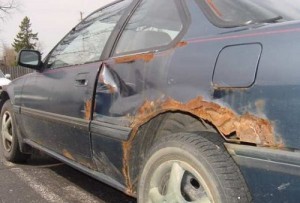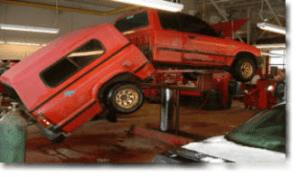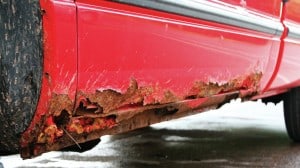Where Vehicles Rust out Most
The Areas Where Vehicles Rust the Most
 Vehicle maintenance is crucial to keeping a car functional and visually appealing. Besides this, it also ensures that you get the optimal resale value when you decide to sell it. Thus, vehicle owners are mostly invested in getting their cars polished and washed to remove mud and dirt, which otherwise lowers their rides’ appearance.
Vehicle maintenance is crucial to keeping a car functional and visually appealing. Besides this, it also ensures that you get the optimal resale value when you decide to sell it. Thus, vehicle owners are mostly invested in getting their cars polished and washed to remove mud and dirt, which otherwise lowers their rides’ appearance.
However, one thing that can be very problematic for vehicle owners and damaging for the car is rust. This is because before you know it, the damage gets done. Therefore, it is advisable to take measures to control and prevent rust beforehand before it damages your car.
As you already know, rust is largely caused by road salt and brine that are used for de-icing the roadways. However, do you know what areas are the trigger points and in which areas vehicles rust the most? Read on to find out.
Trigger Points for Rust
To better understand where the vehicles rust the most, it is crucial to first learn about the types of rust. Vehicles experience two types of rust. These are surface and structural rust.
Surface Rust
The area where surface rust is common is the hood. It is a stone chip on the hood. It looks like a scratch that goes through the paint. Initially, it won’t be worrisome, but after a year or two, it will begin to bubble and become unsightly. Since the surface rust takes a while to become a rust hole, you have ample time to fix it. However, that’s not the case with structural rust.
Structural Rust
 On the other hand, structural rust occurs at seams and undercarriage. It can’t be spotted easily, but it spreads quickly and damages the car severely, unlike surface rust. Rust begins on the inside. To be precise, it occurs on the seams and in the lower six inches of the panel. The rust occurs in these areas because of the road brine.
On the other hand, structural rust occurs at seams and undercarriage. It can’t be spotted easily, but it spreads quickly and damages the car severely, unlike surface rust. Rust begins on the inside. To be precise, it occurs on the seams and in the lower six inches of the panel. The rust occurs in these areas because of the road brine.
As the salty water splashes the vehicle undercarriage and tires, it seeps into the tiny crevices and cracks of the seams and gets trapped. Thus, as the lower body of the car bears the brunt, the rust begins to spread gradually, causing a great deal of damage to your vehicle.
Prevention is Cure
Prevention is indeed the cure. Therefore, consider taking early action before rust eats away your car silently. The best way to prevent rust from spreading and damaging your car is NH Oil Undercoating. The potent formulation of this product is designed exclusively to rustproof your vehicle. It is a self-healing formula that not only protects your vehicle from rust but also heals the damages already to your car due to corrosion/rust. It seeps deep inside the crevices and seams, pushing out moisture that leads to oxidation and corrosion. For more information or to order, contact us today.
If you’ve been following this blog for long, you know that vehicles rust the most in what’s called the ‘salt belt,’ which means  anywhere road maintenance crews put salt or other deicing chemicals on the roads to help keep us all from slipping on the ice and crashing into one another. But where on the vehicle itself does the most rust occur? Kevin Reed, the coauthor of the travel blog Travel with Kevin and Ruth, a native of Ottawa, Ontario, Canada, and 20-year veteran of the auto body and paint industry, gives this answer:
anywhere road maintenance crews put salt or other deicing chemicals on the roads to help keep us all from slipping on the ice and crashing into one another. But where on the vehicle itself does the most rust occur? Kevin Reed, the coauthor of the travel blog Travel with Kevin and Ruth, a native of Ottawa, Ontario, Canada, and 20-year veteran of the auto body and paint industry, gives this answer:
Cars almost always rust in the same places: seams, and the lower six inches of any panel.
Before that, he explains that while all rust is essentially the same, for practical purposes we can think of it as coming in two different kinds:
Cars can have two different types of rust. There is “surface” rust, and there is “structural” rust. It’s actually the same rust, but we call it different names because of where it appears. Surface rust is what you might see if you get a stone chip on your hood or a scratch that goes right through the paint. And after a couple of years it starts to bubble. It’s unsightly, but it’s not a structural problem. And surface rust takes many many years to become an actual rust hole. Structural rust happens at seams and normally starts on the inside of a panel where you can’t even see it. Even though you can’t see it, it’s the worst type of rust. Because the rust starts on the inside of the panel, by the time you see it, it has worked it’s way from the inside to the outside, and now it’s a rust hole!
So the rust Kevin’s talking about here, occurring at seams and in the lower six inches of any panel, is structural rust. Obviously, stone chips and scratches can happen anywhere. Seam rust happens because brine (salty water splashed onto the vehicle from winter roadways) seeps into the tiny cracks and crevices of the seams and gets trapped there. It’s harder for the brine to fall off, and it takes much longer to evaporate than on smooth body surfaces with no crevices or other features.
Lower body panel rust happens because that’s what makes the brunt of all the splashing and rock-throwing from the tires. In fact, speaking of stone chips, the rocker panels and the bottoms of the door panels really take a beating if you drive on gravel roads. Combine gravel roads with winter deicing brine, and you’ve got a recipe for rust. Kevin has the tools, time, and patience to take his little blue car apart every year, spray it with rustproofing, and put it back together again. Judging from her responses to the rustproofing post’s comments, Ruth seems to be very proud of him, and rightly so.
For Canadians who are not intrepid do-it-yourselfers, he recommends the rustproofing chain Krown (Kevin uses Krown’s product, himself). New Hampshire’s equivalent to Krown is NH Oil Undercoating. They use the same basic product (although at The Rust Stop Pros, the exact formula is subject to change in response to changes in automotive technology and deicing trends), and they apply it in basically the same way.

 Buy US Direct
Buy US Direct Buy CA Direct
Buy CA Direct Buy EU Direct
Buy EU Direct Buy DE Direct
Buy DE Direct